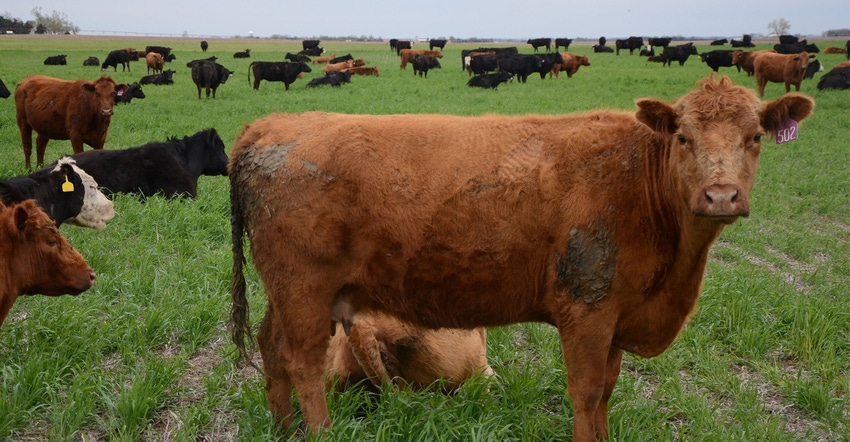February 27, 2019

By Jay Parsons
One of the biggest risks when planting annual forages, especially on nonirrigated ground, is getting the right amount of precipitation to make it grow.
If the annual forage production is taking the place of a fallow period, especially in western Nebraska, there also may be concerns about the effect it has on the soil moisture available for the primary grain crops in the rotation.
To manage this risk, producers may want to consider buying a crop insurance policy under the Annual Forage Insurance Plan. To be eligible for coverage under AFIP, producers must be planting the annual forage crops for use as livestock feed or fodder.
AFIP is a pilot crop insurance program offered under the oversight of the USDA Risk Management Agency. It was first offered in 2014 in Nebraska, Kansas, South Dakota, North Dakota, Oklahoma and Texas. It since has been expanded to include coverage in Colorado and New Mexico.
Coverage periods
Like the Pasture, Rangeland, Forage (PRF) pilot insurance program, AFIP is based on precipitation index data provided by the National Oceanic and Atmospheric Administration Climate Prediction Center.
It is available for four different growing seasons tied to three-month planting periods that cover the entire year starting July 16 and running to July 15 the following year. Each growing season has a six- to seven-month coverage period to insure precipitation levels on chosen two-month intervals:
• Growing season 1. Planting dates: July 16 to Oct. 15; rainfall coverage available from Sept. 1 to March 31.
• Growing season 2. Planting dates: Oct. 16 to Jan. 15; rainfall coverage available from Dec. 1 to June 30.
• Growing season 3. Planting dates: Jan. 16 to April 15; rainfall coverage available from March 1 to Sept. 30.
• Growing season 4. Planting dates: April 16 to July 15; rainfall coverage available from June 1 to Nov. 30.
Producers can select coverage levels ranging from 70% to 90% of the Expected Grid Index precipitation across a series of two-month intervals spanning the rainfall coverage period for each growing season. Premium subsidies depend upon the coverage level selection and range from 51% to 59%. The sign-up deadline is July 15 for all growing seasons in the coming year.
Catastrophic coverage also is available for AFIP. CAT coverage has a fixed 65% coverage level on precipitation for the entire growing season.
In the years 2014-18, less than 100 AFIP CAT policies have been sold annually nationwide, and only seven policies over that time have earned indemnities because of catastrophic loss. Nebraska producers have yet to buy any AFIP CAT coverage since the program’s inception.

Rising interest in program
Nationally, the 2017 and 2018 policy years each saw an increase in use of the program over the previous year (Table 1). Since its inception in 2014, AFIP has been most popular in Texas and Oklahoma. In 2017, Colorado and New Mexico added to the number of policies sold. In 2018, Texas experienced a large jump in policies earning premiums and indemnities.
In the years 2014-18, 4,425 policies have had premiums paid on them. Of those, 3,968 (90%) have paid out some form of indemnity. The overall loss ratio (total indemnities/total premiums) is 1.34.
The average subsidy level has been a steady 52% over that time, indicating most producers are insuring at the 90% rainfall coverage level. Taking subsidies into account, the average indemnity per dollar of producer premium paid over the 2014-18 period nationally is $2.80.

Participation in AFIP by Nebraska producers has been limited (Table 2). Although 69% of the policies in Nebraska earning premiums have been indemnified over the five years of the program, only an annual average of 18 policies have earned premiums over that time.
By comparison, more than 1,000 PRF policies have earned premiums on precipitation coverage for perennial forage in each of the past three years. Like PRF, good precipitation during the past three years in Nebraska has resulted in a loss ratio for AFIP that has been considerably below the expected loss ratio of 1.00.
With subsidies taken into account, indemnities paid out exceeded producer premiums paid into AFIP in Nebraska only during the first two years of the program. With so few policies being sold and only five years of data, it is difficult to draw any conclusions yet about AFIP as a risk protection tool for Nebraska producers.
However, as use of annual forages expands in Nebraska cropping rotations, it is a tool for producers to be aware of and use appropriately. This is especially true in the western part of the state where precipitation is especially prevalent in dryland cropping systems.
Producers interested in using AFIP are encouraged to contact their local crop insurance agent soon as the July 15 deadline is approaching. Information, including an AFIP decision support tool, is available.
Nebraska Extension also has produced a webinar explaining the insurance that is available, along with a NebGuide, G2300 “Precipitation Risk Management for Annual Forages.”
Parsons is an Extension farm and ranch management specialist at the University of Nebraska-Lincoln.
You May Also Like




